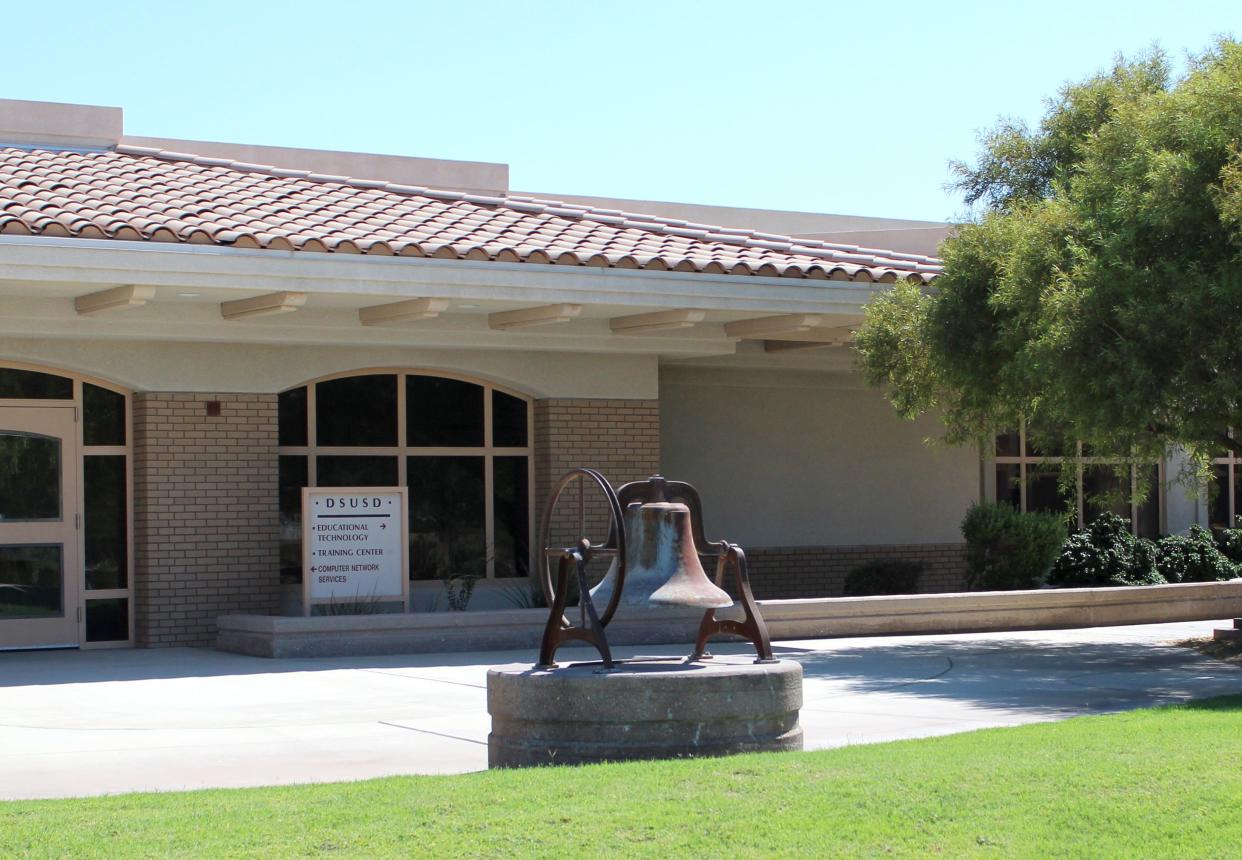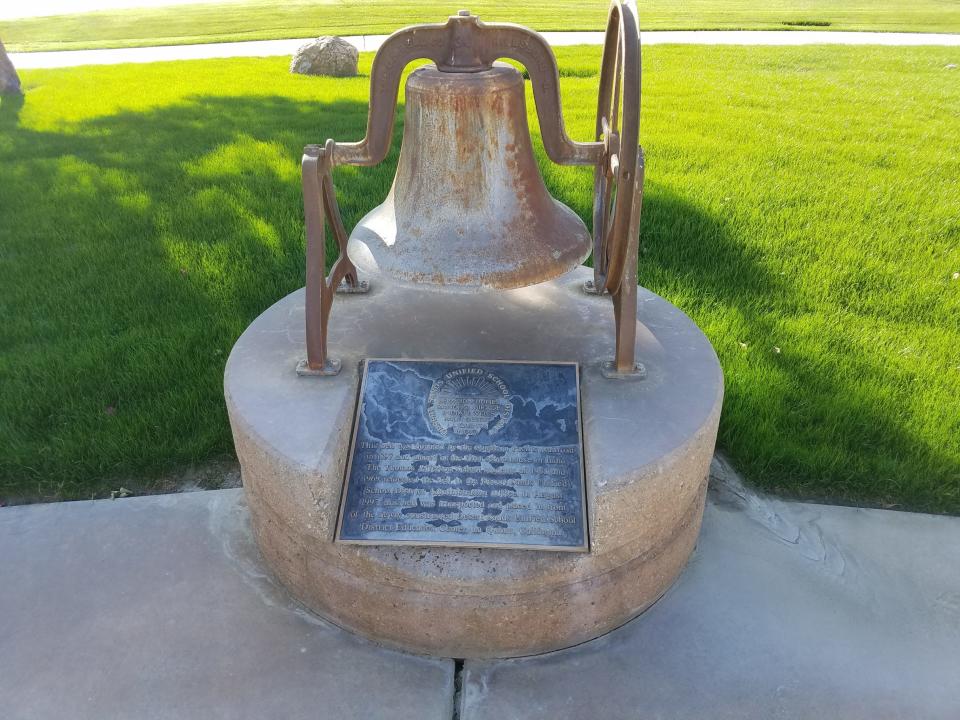Historic Indio school bell, symbol of perseverance, to be restored, preserved

Indio started as a railroad town. As railroads began to cross the country at the end of the 19th century, a stop between Los Angeles and Yuma was necessary to refill the engines with water.
At first the desert stop and the surrounding village were going to be called Indian Wells, but there were numerous southwest places with that moniker. The name “Indio,” Spanish for the word “Indian,” was chosen instead.
The Southern Pacific Railroad started in Los Angeles in 1873 and built eastward through the Coachella Valley, arriving at Indio in 1876. The first permanent building was the railroad’s craftsman-style depot and hotel, the nidus of the new town and the start of tremendous growth. The railroad allowed for connection to the coast and transport of crops. Agriculture sprouted up all around Indio. Citrus, dates, onions, cotton and grapes were highly profitable. Agriculture required workers.
Some of these itinerant farm hands eventually put down roots, building a school for their children. The Southern Pacific Railroad donated a large, cast-iron bell for the first schoolhouse in 1897.

Indio resident Chuck King has a special connection to the bell. “For my father, at age 9, this bell was part of his early education experience. Dad’s family, subsistence sharecroppers from Midland, Arkansas, suffered from ‘The Dust Bowl’ of the Midwest in the 1930s. It destroyed many small family farms from Arkansas to Oklahoma. Some large farming enterprises in California sought to take advantage of the plight of the afflicted farming families by luring large numbers of them to their fields with promises of prosperity, jobs and a new life.”
Hundreds of thousands of people traveled to California in hope of that new life immortalized in John Steinbeck’s class novel “The Grapes of Wrath.” The hardship they endured is unimaginable today.
King’s family was part of that migration. His father told stories about his parents, brothers and sister living in an Indio farm-labor camp on the east side of Van Buren Street, scratching out a hard living. King remembers his father as a man of quiet composure, reticent to recall “the hunger, the toil, the persecution” and instead concentrating on the “simple joys found in surviving from day to day.”
King’s family worked in the fields but found a brief respite from the hard labor when they were used as extras in the 1940 movie “The Grapes of Wrath.” King recalls, “They were hillbilly musicians that played during the final climactic dance scene. They were also musicians in real life, playing for dances on weekends at the labor camps and elsewhere when they could.”
King’s father attended the grammar school in Indio, intent on getting an education. King pays tribute for his own blessings to the hardship his family endured. “I owe my education to my father and his influence upon me. I’ll never forget his admonition when I was in elementary school. He did not emphasize getting As or Bs but that I try my hardest. He said the good grades would follow.”
The American dream has been largely achieved through education. Horace Mann, the father of public education in the United States, was born in 1796, just 20 years after the Declaration of Independence. The democratic idea of ubiquitous access to education and therefore to upward mobility was foundational: every child could receive a basic education funded by local taxes. Education was revered as the path to a better life.
Way out west, schools were makeshift, and the first school in Indio was no exception, consisting of a tent shelter from the oppressive sun. The second, an adobe structure, is no longer in existence. But thanks to the railroad, the cast-iron bell would ring out and call children to class like proper schools back East.
By 1909, a one-room clapboard schoolhouse was built at Oasis and Bliss avenues in Indio. Children in kindergarten to eighth grade were taught in that small room from 1909 until 1960. The building was used as a hospital during the Spanish influenza epidemic of 1918 and a community center for countless meetings and functions in the decades that followed.
"It was the schoolhouse in the greater Indio area for a long, long time," said Maureen Boren of the Coachella Valley History Museum. After nearly 30 years at its original site, the schoolhouse was incorporated into the Indio School District and moved to a site on the grounds of the original Roosevelt School campus. Then in 1999 the entire building was moved to where it currently sits at the Coachella Valley History Museum on Miles Avenue. The schoolhouse was rededicated in 2005 after being restored.
As the oldest extant building in Indio, it was officially granted historic landmark status by the Riverside County Board of Supervisors in 2016.
The bell had a similar peripatetic story. It was converted to a monument and placed at the Desert Sands School District office in 1969 and moved to the newly built district office in La Quinta in 1997, where Chuck King, having followed his father’s admonition about education, was working in the Information Technology department for the district, having retired from a career as an aerospace engineer.
For King, the bell is symbolic of the fortitude and persistence of his father. “Where would I be, what would I be doing, had my father given up on school because of the hardships he endured, and walked away from an education?” King thinks of the bell as also symbolizing the path to a better life through education for students today, despite the difficulties they too may be enduring.
After 125 years in Indio, the bell will begin to be refurbished starting Sept. 19 and will be rededicated when it is shiny and new again.
King has since also retired from the school district, and his father passed away almost 10 years ago, but he notes, “Certainly, his spirit lives on through his large extended family and through me. I will continue to try my very best, in his honor. ... ‘The bell’ has become a symbol for me, of my father, of his legacy, of the education that he encouraged me to obtain and for those of our district who pursue their own educational destiny.”
Tracy Conrad is president of the Palm Springs Historical Society. The Thanks for the Memories column appears Sundays in The Desert Sun. Write to her at pshstracy@gmail.com.
This article originally appeared on Palm Springs Desert Sun: Indio school bell, symbol of perseverance, to be restored, preserved

